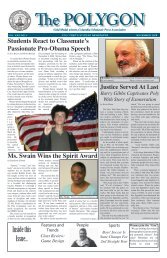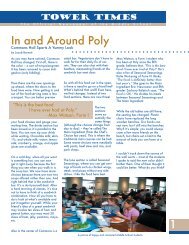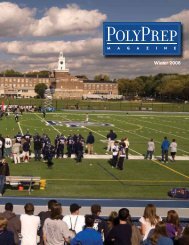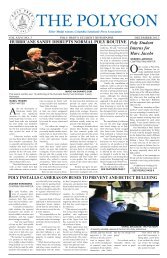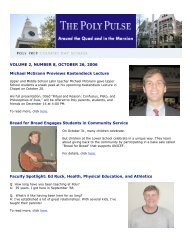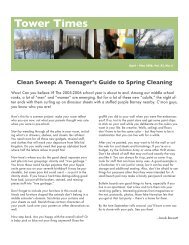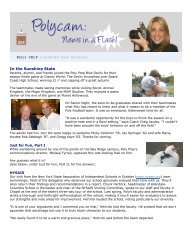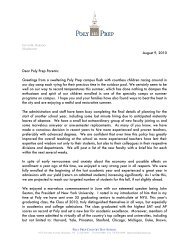Policies Outlining Responses to Harassment, Abuse, and ...
Policies Outlining Responses to Harassment, Abuse, and ...
Policies Outlining Responses to Harassment, Abuse, and ...
You also want an ePaper? Increase the reach of your titles
YUMPU automatically turns print PDFs into web optimized ePapers that Google loves.
<strong>Policies</strong> <strong>Outlining</strong> <strong>Responses</strong> <strong>to</strong><br />
<strong>Harassment</strong>, <strong>Abuse</strong>, <strong>and</strong><br />
Suspicions of Child Neglect;<br />
Prohibition of <strong>Harassment</strong><br />
As a condition of employment, all faculty <strong>and</strong> staff must adhere <strong>to</strong> common st<strong>and</strong>ards of<br />
decency, goodwill, mutual respect, empathy, <strong>and</strong> sensitivity. The school does not <strong>to</strong>lerate in<br />
any form a violation of personal physical or emotional boundaries.<br />
Adult sexual or other inappropriate intimate relationships with students violates known<br />
criminal, civil, <strong>and</strong> moral laws <strong>and</strong> is categorically prohibited. Complaints of this nature will<br />
be investigated with the greatest urgency <strong>and</strong> are subject <strong>to</strong> the severest <strong>and</strong> most immediate<br />
consequences, including contract termination, notification of law enforcement, <strong>and</strong> arrest.<br />
The working <strong>and</strong> learning environment is one in which students develop relationships <strong>and</strong><br />
learn <strong>to</strong> mature without fear of intimidation, humiliation or degradation. Inappropriate<br />
behavior, either verbal or physical, which disregards the self-esteem <strong>and</strong> physical or<br />
emotional safety of others, is unacceptable. We list here examples of the most egregious<br />
behavior:<br />
• comments which are demeaning with respect <strong>to</strong> race, religion, ethnic origin, gender,<br />
sexual orientation or physical challenge;<br />
• obscene or suggestive remarks or jokes, verbal abuse, insults<br />
• uninvited pressure for sexual activity whether explicit or implicit;<br />
• displays of offensive 01' demeaning materials;<br />
• Hazing <strong>and</strong> threats;<br />
• false accusations of harassment; <strong>and</strong><br />
• retaliation <strong>to</strong>ward someone making a complaint about harassment.<br />
Any alleged violations of the exceptions stated above involving students, or students <strong>and</strong><br />
faculty <strong>and</strong>/or staff, need <strong>to</strong> be taken seriously <strong>and</strong> reported <strong>to</strong> a Division Head.<br />
Complaints against Division Heads shall be made <strong>to</strong> the Headmaster. The appropriate<br />
senior administra<strong>to</strong>r shall promptly investigate the complaint. Following a full investigation of<br />
the circumstances, if the administra<strong>to</strong>r determines that the alleged violation did indeed occur,<br />
he/she may recommend sanctions.<br />
Page 1
Sexual <strong>Harassment</strong> <strong>and</strong> <strong>Abuse</strong><br />
The School's policy on sexual misconduct detailed here addresses harassment in all forms. It<br />
is an affirmative duty of any adult 01' student in the community <strong>to</strong> report immediately <strong>to</strong> the<br />
appropriate school officials any instance of sexual abuse or harassment directed against a<br />
child or another adult.<br />
There is a legal line between sexual harassment <strong>and</strong> sexual abuse. Sexual harassment<br />
involves verbal behavior while sexual abuse involves physical <strong>to</strong>uching. Sexual harassment<br />
<strong>and</strong> sexual abuse cause humiliation <strong>and</strong> fear while legitimate nonsexual <strong>to</strong>uching <strong>and</strong><br />
physical contact offer congratulations, consolation, or commiseration that lends support <strong>to</strong><br />
another human being. The School recognizes that some physical contact may be a regular<br />
part of appropriate social, athletic, <strong>and</strong> educational experiences. For instance, greetings with<br />
affectionate but innocent hugging, patting on the back during athletic events. Similarly,<br />
adults who are questioning a student’s adherence <strong>to</strong> the dress code, even if the comments<br />
are addressed <strong>to</strong> a member of the other sex, may legitimately make comments about clothing<br />
or appearance. Conduct, which might not constitute sexual harassment if performed only<br />
once, may become sexual harassment if repeated or intensified particularly when it follows a<br />
request <strong>to</strong> cease the behavior.<br />
Sexual harassment is unwelcome conduct that refers or relates in some way <strong>to</strong> another<br />
person's gender. Anyone may become the victim of sexual harassment, regardless of gender<br />
or sexual orientation. It may involve physical contact or verbal conduct. It should be noted<br />
that unwelcome or unwanted <strong>to</strong>uching, even if not sexual or gender-based in nature, may be<br />
considered assault or battery.<br />
Sexual harassment can take two forms: “quid pro quo" <strong>and</strong> "hostile environment.” Both can<br />
deny or limit a student’s, faculty, or staff member's ability <strong>to</strong> participate in or <strong>to</strong> receive<br />
benefits, services, or opportunities from the school's programs. "Quid pro quo" harassment<br />
occurs if a school employee (including, but not limited <strong>to</strong>, administra<strong>to</strong>rs, teachers, coaches,<br />
specialists, <strong>and</strong> support <strong>and</strong> maintenance staff members) causes a student or employee <strong>to</strong><br />
believe that he or she must submit <strong>to</strong> unwelcome sexual conduct in order <strong>to</strong> participate in a<br />
school program or activity.<br />
It can also occur if an employee causes a student <strong>to</strong> believe that the employee will make an<br />
educational decision based on whether or not the student submits <strong>to</strong> the sexual conduct. This<br />
also means that an adult member of the community might believe that advancement or<br />
continued employment is dependent on submitting <strong>to</strong> sexual conduct.<br />
Hostile environment harassment occurs if unwelcome sexually harassing conduct is so severe,<br />
persistent, or pervasive that it affects a student's or faculty or staff member's ability <strong>to</strong><br />
participate in an educational program or activity, or creates an intimidating, threatening or<br />
abusive sexual environment. A hostile environment can be created by a school employee,<br />
another student, or even someone visiting the School. Many fac<strong>to</strong>rs are considered in<br />
Page 2
determining whether conduct creates a sexually hostile environment, including the frequency<br />
<strong>and</strong> duration of the conduct.<br />
Sexually harassing conduct includes, but is not limited <strong>to</strong>:<br />
• sexual advances, or pressure for sexual activity or sexual favors;<br />
• <strong>to</strong>uching of a sexual (or a sexually suggestive) nature;<br />
• displaying or distributing sexually explicit drawings, pictures, objects or writings;<br />
• sexual or obscene gestures or jokes;<br />
• <strong>to</strong>uching oneself sexually or talking about one's sexual activity in front of others;<br />
• spreading rumors or rating other students, faculty or staff as <strong>to</strong> sexual activity or<br />
performance; <strong>and</strong><br />
• public displays of affection which are insensitive <strong>to</strong>wards the level of comfort of<br />
students <strong>and</strong>/or adults who may be in the vicinity.<br />
Gender-based harassment is also specifically prohibited. This is harassment that includes<br />
acts of verbal, nonverbal, or physical aggression, intimidation, or hostility based on sex<br />
stereotyping, but not involving conduct of a sexual nature.<br />
Reporting Procedures<br />
The responsibility <strong>to</strong> report instances of sexual harassment or abuse rests with all members of<br />
the School community, not just those who feel themselves directly victimized by such behavior.<br />
In cases of perceived or actual harassment, students are <strong>to</strong>ld <strong>to</strong> report such incidences<br />
directly <strong>to</strong> their respective Form Dean. Students <strong>and</strong> adults alike may approach a trusted<br />
member of the community with their concerns. It is not the role of this initial contact <strong>to</strong><br />
investigate or try <strong>to</strong> solve the problem individually, but <strong>to</strong> encourage the complainant <strong>to</strong><br />
initiate the official process.<br />
Any teacher or administra<strong>to</strong>r who comes <strong>to</strong> hear or know complains <strong>and</strong> allegations of sexual<br />
misconduct will initiate the following actions:<br />
1. Informs the supervising administra<strong>to</strong>r <strong>and</strong> the Headmaster of the individual(s) named<br />
in the complaint, so that the person or persons can be notified <strong>and</strong> action can be<br />
taken by the supervisor <strong>to</strong> see that the behavior ceases <strong>and</strong> <strong>to</strong> put the accused on<br />
notice of impending disciplinary hearings. The Headmaster will designates an<br />
investiga<strong>to</strong>r <strong>to</strong> collect, in strict confidentiality, statements from complainant, witnesses,<br />
<strong>and</strong> alleged offender(s), <strong>and</strong> who will produce written summaries <strong>and</strong> report back<br />
directly <strong>to</strong> Headmaster.<br />
Page 3
Follow-up Action<br />
1. The complainant should be referred <strong>to</strong> the School psychologist or other appropriate<br />
individual for counseling if the situation dem<strong>and</strong>s it.<br />
2. If the offender is found liable for sexual misconduct, the disciplinary actions may<br />
include one or more of the following: counseling, sensitivity training, suspension,<br />
expulsion, dismissal, or notification of the local or state authorities.<br />
3. If the complainant is dissatisfied with the h<strong>and</strong>ling of the case, remedy may be sought<br />
by contacting the Office of Civil Rights, New York State Division of Human Rights, the<br />
EEOC or New York City Commission on Human Rights.<br />
False Complaints <strong>and</strong> Retaliation<br />
1. Retaliation against anyone, who, in good faith, reports perceived harassment or<br />
discrimination, or who participates in an investigation of a complaint, is prohibited.<br />
Such acts of reprisal are subject <strong>to</strong> disciplinary action.<br />
2. Anyone who makes a false complaint of sexual harassment or abuse is also subject <strong>to</strong><br />
disciplinary action.<br />
Sexual Misconduct: Prevention <strong>and</strong> Education<br />
1. A training workshop will be conducted for the whole faculty every other year.<br />
2. New faculty orientation will include time <strong>to</strong> discuss issues of sexual harassment <strong>and</strong> <strong>to</strong><br />
familiarize the new member of the faculty with school policies.<br />
3. Issues of sexual harassment <strong>and</strong> abuse will be highlighted at fall orientation for<br />
students.<br />
4. A team of faculty, staff, parents, <strong>and</strong> students who have been trained on issues <strong>and</strong><br />
policy will serve as resources for ongoing education <strong>and</strong> awareness program<br />
Child <strong>Abuse</strong> Reporting Requirement<br />
Reporting steps for teachers who see evidence of child maltreatment or abuse, or who suspect<br />
such abuse:<br />
1. The teacher must immediately report any evidence of child maltreatment, or even the<br />
suspicion of abuse, <strong>to</strong> the Division Head<br />
2. The teacher or Division Head must immediately call the CPS Hotline<br />
3. The teacher* or Division Head must file a report with CPS within 48 hours. The report<br />
must include a statement by the teacher or administra<strong>to</strong>r who first witnessed the abuse.<br />
*Please note that the person who suspects or has evidence of child abuse may allow the Division Head <strong>to</strong> call<br />
Child Protective Services rather than doing so herself, but still holds the primary legal responsibility that the call is<br />
made in a timely manner.<br />
Page 4
Under revisions <strong>to</strong> Section 413 of the Social Services Law, school officials, administra<strong>to</strong>rs,<br />
faculty <strong>and</strong> health care professionals employed by Poly Prep have an affirmative duty <strong>to</strong> report<br />
when they have -reasonable cause <strong>to</strong> suspect" that a child has been abused or maltreated or<br />
where a parent, guardian or other individual legally responsible for the child states from<br />
personal knowledge facts, conditions or circumstances that, if true, would render the child an<br />
abused or maltreated child. Evidence, or suspicion, of abuse is the immediate responsibility<br />
of the teacher or administra<strong>to</strong>r who first witnesses it. A teacher or administra<strong>to</strong>r who suspects<br />
abuse must act. Following guidelines set out by the New York State Teachers Association on<br />
the revision <strong>to</strong> Section 413:<br />
As soon as a teacher reporter has a reasonable cause <strong>to</strong> suspect abuse or maltreatment, he<br />
or she or the Division Head must report his or her concerns immediately by telephone <strong>to</strong> the<br />
New York State Central Register of Child <strong>Abuse</strong> <strong>and</strong> Maltreatment (SCR). Oral reports <strong>to</strong> the<br />
hotline must be followed within 48 hours by a written report on Form LDSS 2221A <strong>to</strong> the<br />
local Child Protective Service (CPS). A copy of this m<strong>and</strong>ated reporter form can be obtained<br />
by contacting your local CPS office, or by accessing the New York State Office of Children<br />
<strong>and</strong> Family Services (OCFS) website at www.ocfs.state.ny.us <strong>and</strong> clicking on the "Forms"<br />
"LDSS222IA" links. In addition, where there are visibly apparent traumas, school officials,<br />
administra<strong>to</strong>rs, faculty <strong>and</strong> health care professionals shall immediately notify the Division<br />
Head or his or her designated agent, who shall then take or cause <strong>to</strong> be taken color<br />
pho<strong>to</strong>graphs of visible trauma <strong>and</strong> shall, if medically indicated, cause <strong>to</strong> be performed a<br />
radiological examination on the child.<br />
Page 5




